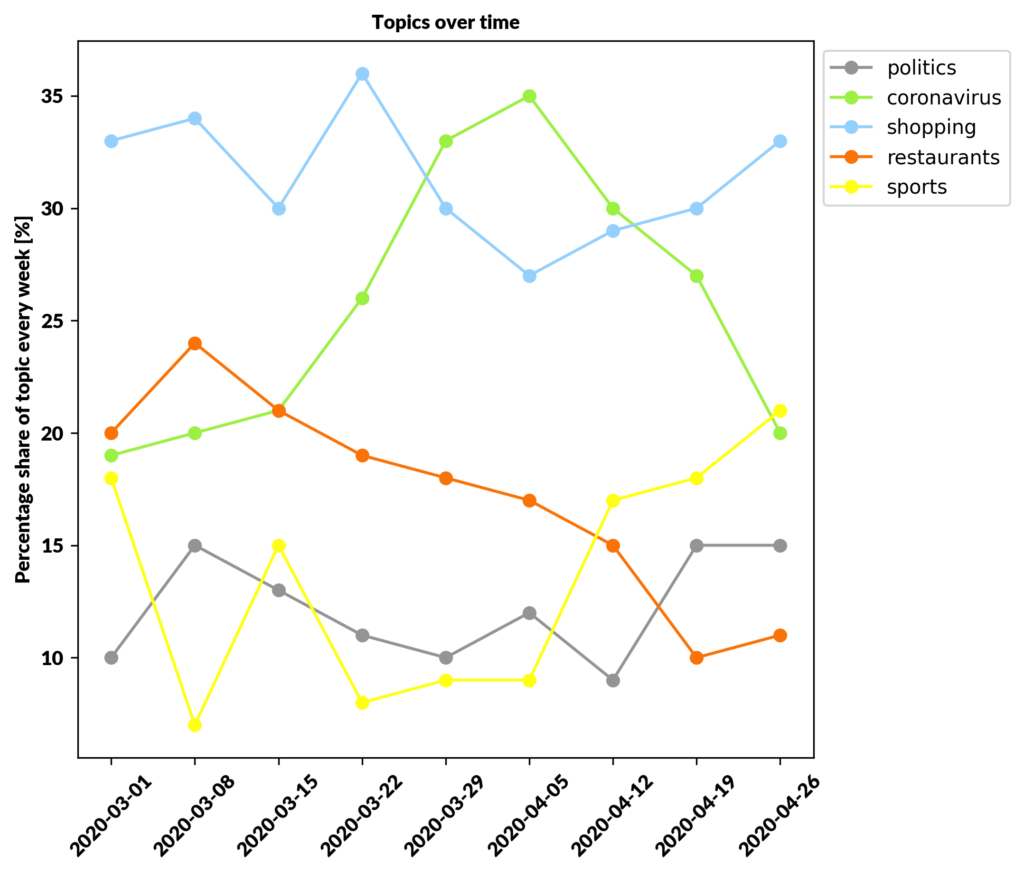Social media posts can tell you so many things about your audience, their interests, perceptions, and what topics are relevant to them. Why not just give them a questionnaire, then? Wouldn’t you find out more by asking them directly?
Here’s why that’s unrealistic. Questionnaires and surveys are time-consuming so your customers probably won’t want to spend so much time on them. Answer rates will be low, so you won’t get to see the full picture.
However, your fans and followers on social media are active to some extent. If they’re following your Page or profile, then they can interact with you if your posts are interesting enough. It’s just so much easier to get more opinions about your brand, products, and industry over social media, as long as you have the right tools.
What is topic modeling?
Imagine how much engagement your brand gets on your social media channels. There is no simple way to analyze all of that text as one person unless you’re going to spend hours copy-pasting everything your users are saying. The easy way to do this is to use a machine learning model (using Natural Language Processing) that will do this at a faster rate with more accuracy than most people. But what does it do exactly?
The simplified version is this: you gather all of the comments, tweets, or posts, and you have the model generate overarching topics or themes that frequently appeared. There are different methods (algorithms) that you can use to perform topic modeling on social media texts and you can read more about them here.
So, what are the outcomes of topic modeling? Besides gathering large chunks of data and analyzing them at a faster rate, you can create models to answer specific questions or resolve unique problems.
What kind of texts can be analyzed with topic modeling?
Basically, all of the written conversations on social media can be analyzed in some way (as long as it isn’t private or hidden). That means that you would be able to get information about texts such as online reviews, tweets, and Facebook comments and posts. But just as there are different texts that we can analyze, there are also many ways that we can visualize the data.
You could visualize your data in a few different ways to answer your own questions about what your audience is talking about. Depending on the need or how in-depth you want your analysis to be, you can make use of:
- Word clouds. They’re a simple way to illustrate what words regularly came up in a text. Based on the contents of the word cloud, you could conclude that the overarching topic that was popular in your comments was politics or medicine.

- Plotting topics to see how your audience’s interests have changed with time.

- Bar graphs showing how often topics came up overall in your social media posts.

Here’s how you could use topic modeling quite easily. You’re running a Facebook Page for a PR agency, and you want to compare what topics your audience talked about before and after COVID started. In January, your audience was mostly talking about workshops, events, and news in the industry. In June, they’re talking about safety regulations, hazards, and social distancing. Suddenly, older topics aren’t nearly as popular. This by itself can tell you that their priorities have changed, and you should focus more on that topic in order to increase the overall performance of your communication and ads.
Pretty informative, right? 😉
How can I perform this analysis?
So you’ve seen how this data can be visualized, but you want to save time learning how to use the software to produce such graphs. Don’t worry though, because we have you covered.
Actually, you can get a deeper insight into what your audience is saying by having experienced data scientists perform these analyses for you thanks to machine learning. At Sotrender, we have a team of R&D researchers who can prepare unique reports for your business. For example, one of our talented data scientists wrote an article where you can see how we prepared a topic modeling analysis for Collegium Civitas.
All of the graphs you’ve seen so far are Sotrender’s own data visualizations. If you think that they may be of interest to your business, feel free to message us. We can discuss whether this is the right analysis for your business and help you learn what your audience is currently interested in.
NLP is obviously useful in a lot of ways for marketers, social media managers, and PR specialists. If you truly want to understand the conversations that your users are having surrounding or about your business, you’ll need the help of AI-powered reports and analyses.
Read more about AI and machine learning here:



